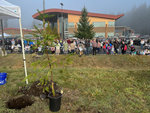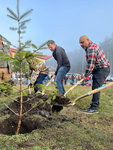


On Jan. 20, members of the Nisqually, Puyallup and Squaxin tribes gathered near the Nisqually Administration Building grounds for a tree planting ceremony to commemorate the 169th anniversary of the Medicine Creek Treaty signing.
The tree planted was a Douglas fir. It was a direct descendant of the fir tree the treaty was signed under.
Originally signed on Dec. 26, 1854, the treaty was signed by members of the Nisqually, Puyallup, Steilacoom, Squaxin, Muckleshoot, S’Homamish, Stehchass, T’Peeksin, Squi-aitl and Sa-heh-wamish tribes.
Chief Leschi of the Nisqually Indian Tribe rejected the treaty’s first iteration as it would have forced the entire nation to lose access to the Nisqually River. The subsequent treaty gave land allotments to the tribes and secured hunting and fishing rights for them, but it did not stop Washington state from taking the land later for Fort Lewis.
The treaty signing occurred in a Douglas fir tree grove on the Nisqually River Delta, specifically at the mouth of Medicine Creek, which is now known as McAllister Creek. The original tree it was signed under survived until 1979, when it was killed by disease. The stump from the tree was allowed to remain until it fell during severe storms in 2007.
Seeds were saved from the original tree and during the ceremony on Jan. 20, a sapling was planted. Nisqually Tribal Council Vice Chair Antonette Squally spoke to the Nisqually Valley News about what the tree meant to her people and culture.
“It was truly touching to bear witness to something that was a living being at the time of our hereditary chiefs and our sub-chiefs and our ancestors for that matter and their families,” Squally said. “It meant a lot to all of us who were there and in the presence of it, it was a real spiritual awakening of all of those chieftainship names on the treaty.”
In addition to the tree planting, Squally translated the treaty into the tribe’s original language, Lushootseed.
Both printed copies and T-shirts with the treaty were handed out and Squally explained this was the first time most of those in attendance had a physical copy of the treaty to display.
The idea for the tree planting came to Squally’s mother, when she was invited to view the original treaty which is currently being kept at the National Native American Museum in Washington, D.C.
“She said, ‘whatever happened to that tree because I know there’s seedlings?’ She reminded me that Uncle Leonard told her that there were seedlings from the tree and we needed to get some of those and plant them on the reservation boundaries,” Squally said. “That’s what made it so important, those teachings from our elders, they remind you of things that need to happen and the tribe should’ve done this a long time ago.”
While the original tree died in 1979, the Holly Tree Farms saved some seeds and had been growing seedlings, according to Squally. The farm’s owner, Bob Barnes, donated more than just the treaty tree to the tribe.
“He even donated 50 redwood cedars to the tribe,” Squally said.
Members of the Squaxin and Puyallup tribes got treaty tree seedlings to take back and plant on their own reservations. Squally stated a seedling was saved to give to the Muckleshoot who were not present at the Jan. 20 ceremony.
“I just want to give thanks to our elders for the teachings that they have bestowed upon us. And these are some of those teachings, keeping that history alive. If it wasn’t for them, all of us wouldn’t be here,” Squally said.
A translation of the treaty can be found online at goia.wa.gov/tribal-government/treaty-medicine-creek-1854.